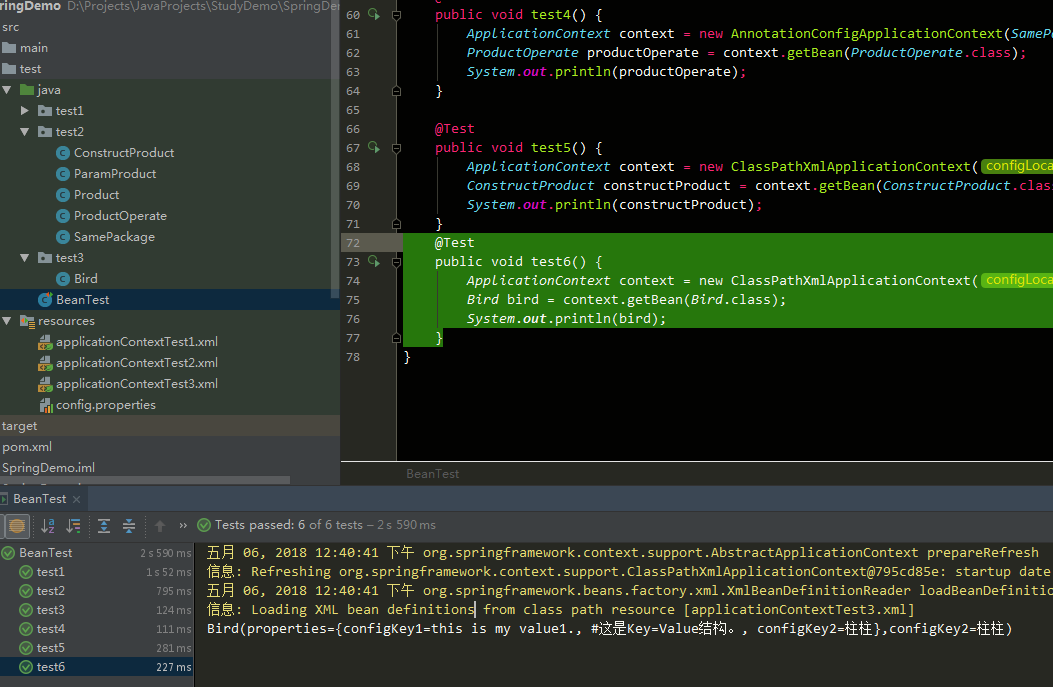使用Spring框架入门二:基于注解+XML配置的IOC/DI的使用
使用Spring框架入门二:基于注解+XML配置的IOC/DI的使用
一、简述
本文主要讲使用注解+xml配合使用的几种使用方式。基础课程请看前一节。
二、步骤
1、为Pom.xml中引入依赖:本例中使用的是spring-context包,引入此包时系统会自动导入它的依赖包spring-beans\spring-
core\spring-expression\spring-context.
<?xml version="1.0" encoding="UTF-8"?>
<project xmlns="http://maven.apache.org/POM/4.0.0"
xmlns:xsi="http://www.w3.org/2001/XMLSchema-instance"
xsi:schemaLocation="http://maven.apache.org/POM/4.0.0 http://maven.apache.org/xsd/maven-4.0.0.xsd">
<modelVersion>4.0.0</modelVersion>
<groupId>sindrol</groupId>
<artifactId>SpringDemo</artifactId>
<version>1.0-SNAPSHOT</version>
<dependencies>
<dependency>
<groupId>org.springframework</groupId>
<artifactId>spring-context</artifactId>
<version>5.0.5.RELEASE</version>
</dependency>
<dependency>
<groupId>org.springframework</groupId>
<artifactId>spring-aop</artifactId>
<version>5.0.5.RELEASE</version>
</dependency>
<dependency>
<groupId>junit</groupId>
<artifactId>junit</artifactId>
<version>4.12</version>
</dependency>
<dependency>
<groupId>org.projectlombok</groupId>
<artifactId>lombok</artifactId>
<version>1.16.20</version>
</dependency>
</dependencies>
</project>
2、在/src/java/test2下建立下列类:
package test2;
import lombok.Data;
import org.springframework.beans.factory.annotation.Value;
import org.springframework.stereotype.Component;
import org.springframework.stereotype.Controller;
import org.springframework.stereotype.Repository;
import org.springframework.stereotype.Service;
@Data
@Component(value = "product1")
//@Controller("product1") //Controller也是一个Component,一般用于WEB中的Action
//@Service("product1")//Service也是一个Component,一般用于业务逻辑类
//@Repository("product1")//Repository也是一个Component,一般用于持久层类
public class Product {
@Value("Sindrol")
private String name;
@Value("1.5")
private float price;
}
package test2;
import org.springframework.beans.factory.annotation.Autowired;
import org.springframework.stereotype.Service;
import javax.annotation.Resource;
@Service("productOperate")
public class ProductOperate {
//使用Resource也可以实现值的注入,使用Resource和Autowired的区别在于,Resource可以指定的名称必须和要注入Comment名称相同的对象,名称不一致时出错。
@Resource(name = "product1")
private Product product;
@Autowired
private Product product2;
@Override
public String toString() {
return "ProductOperate(product=" + product + " ,product2=" + product2 + ")";
}
}
package test2;
import jdk.nashorn.internal.objects.annotations.Constructor;
import lombok.Data;
import org.springframework.beans.factory.annotation.Autowired;
import org.springframework.beans.factory.annotation.Value;
import org.springframework.context.annotation.Scope;
import org.springframework.context.annotation.ScopedProxyMode;
import org.springframework.stereotype.Component;
import javax.annotation.Resource;
import java.util.PrimitiveIterator;
@Data
@Component("paramProduct1")
//@Scope("prototype")
@Scope("singleton")
public class ParamProduct {
@Value("JAVA书集")
private String name;
private float price;
private Product product;
public ParamProduct(@Autowired Product product, @Value("Sindrol") String name, @Value("28") float price) {
this.product = product;
this.name = name;
this.price = price;
}
}
package test2;
import java.util.List;
public class ConstructProduct {
private List<String> list;
public ConstructProduct(List<String> list) {
this.list = list;
}
@Override
public String toString() {
return "ConstructProduct(list=" + list + ")";
}
}
package test2;
import org.springframework.context.annotation.ComponentScan;
//使用ComponentScan定义类所在包开头名称。
@ComponentScan(basePackages = "test2")
public class SamePackage {
}
3、在/src/test/resources(注意:标记此resources为测试资源)下建立applicationContextTest2.xml,内容如下:
<?xml version="1.0" encoding="UTF-8"?>
<beans xmlns="http://www.springframework.org/schema/beans"
xmlns:xsi="http://www.w3.org/2001/XMLSchema-instance"
xmlns:context="http://www.springframework.org/schema/context"
xsi:schemaLocation="http://www.springframework.org/schema/beans
http://www.springframework.org/schema/beans/spring-beans.xsd
http://www.springframework.org/schema/context
http://www.springframework.org/schema/context/spring-context.xsd">
<!--开启注解扫描(扫描test2开头的包)-->
<context:component-scan base-package="test2"/>
<!--引入配置文件,引入后值中可使用变量。引入方法一:-->
<!--<context:property-placeholder location="config.properties" file-encoding="UTF-8"/>-->
<!--引入配置文件,引入后值中可使用变量。引入方法二:-->
<bean id="propertyConfigurer"
class="org.springframework.beans.factory.config.PropertyPlaceholderConfigurer">
<property name="location" value="config.properties" />
<property name="fileEncoding" value="UTF-8"/>
</bean>
<!--扫描属性上面的注解-->
<!--<context:annotation-config></context:annotation-config>-->
<bean id="constructProduct" class="test2.ConstructProduct">
<constructor-arg>
<array>
<!--这里可以使用引入的properties文件的变量 -->
<value>${configKey1}</value>
<value>${configKey2}</value>
<value>list_item3</value>
</array>
</constructor-arg>
</bean>
</beans>
4、在/src/test/resources下建立一个名为config.properties的文件,内容如下:(这里一定要注意文件的编码,IDEA在Windows下默认新建的properties是ASCII编码,所以要转成UTF-8编码后测试。)
#这是Key:Value结构。
configKey1:this is my value1.
configKey2:柱柱
5、在/src/test/java/BeanTest下添加Junit测试方法:
import org.junit.Test;
import org.springframework.context.ApplicationContext;
import org.springframework.context.annotation.AnnotationConfigApplicationContext;
import org.springframework.context.support.ClassPathXmlApplicationContext;
import test1.Student;
import test1.User;
import test2.*;
import test3.Bird;
public class BeanTest {
@Test
public void test2() {
//ApplicationContext context = new AnnotationConfigApplicationContext(SamePackage.class);
ApplicationContext context = new ClassPathXmlApplicationContext("applicationContextTest2.xml");
Product product1 = (Product) context.getBean("product1");
System.out.println(product1);
}
@Test
public void test3() {
ApplicationContext context = new AnnotationConfigApplicationContext(SamePackage.class);
ParamProduct paramProduct1 = (ParamProduct) context.getBean(ParamProduct.class, new Object[]{ //构造函数值
context.getBean(Product.class),
"Product初始名字",
23
});
System.out.println(paramProduct1);
ParamProduct paramProduct2 = (ParamProduct) context.getBean(ParamProduct.class, new Object[]{ //构造函数值
context.getBean(Product.class),
"Product初始名字2",
333
});
System.out.println(paramProduct2); //注意,paramProduct2并未进行真实的构造,而是直接取了单例对象。
System.out.println("是否是同一实例:" + (paramProduct1 == paramProduct1));
}
@Test
public void test4() {
ApplicationContext context = new AnnotationConfigApplicationContext(SamePackage.class);
ProductOperate productOperate = context.getBean(ProductOperate.class);
System.out.println(productOperate);
}
@Test
public void test5() {
ApplicationContext context = new ClassPathXmlApplicationContext("applicationContextTest2.xml");
ConstructProduct constructProduct = context.getBean(ConstructProduct.class);
System.out.println(constructProduct);
}
}
6、执行测试,查看测试结果:
test2测试结果:
Product(name=Sindrol, price=1.5)
test3测试结果:
五月 06, 2018 12:40:40 下午 org.springframework.context.support.AbstractApplicationContext prepareRefresh
信息: Refreshing org.springframework.context.annotation.AnnotationConfigApplicationContext@10e92f8f: startup date [Sun May 06 12:40:40 CST 2018]; root of context hierarchy
ParamProduct(name=JAVA书集, price=28.0, product=Product(name=Sindrol, price=1.5))
ParamProduct(name=JAVA书集, price=28.0, product=Product(name=Sindrol, price=1.5))
是否是同一实例:true
test4测试结果:
五月 06, 2018 12:40:40 下午 org.springframework.context.support.AbstractApplicationContext prepareRefresh
信息: Refreshing org.springframework.context.annotation.AnnotationConfigApplicationContext@67a20f67: startup date [Sun May 06 12:40:40 CST 2018]; root of context hierarchy
五月 06, 2018 12:40:40 下午 org.springframework.context.support.AbstractApplicationContext prepareRefresh
信息: Refreshing org.springframework.context.support.ClassPathXmlApplicationContext@31368b99: startup date [Sun May 06 12:40:40 CST 2018]; root of context hierarchy
五月 06, 2018 12:40:40 下午 org.springframework.beans.factory.xml.XmlBeanDefinitionReader loadBeanDefinitions
信息: Loading XML bean definitions from class path resource [applicationContextTest2.xml]
ProductOperate(product=Product(name=Sindrol, price=1.5) ,product2=Product(name=Sindrol, price=1.5))
test5测试结果:
ConstructProduct(list=[this is my value1., 柱柱, list_item3])
三、测试属性文件以Map的形式载入
1、在/src/test/java/test3下建立一个Bird类
package test3;
import org.springframework.beans.factory.annotation.Value;
import org.springframework.stereotype.Component;
import java.util.Map;
@Component
public class Bird {
@Value("#{configProperties['configKey2']}")
private String configKey2;
@Value("#{configProperties}")
private Map<String, String> properties;
@Override
public String toString() {
return "Bird(properties=" + properties + ",configKey2=" + configKey2 + ")";
}
}
2、在/src/test/resources下建立一个applicationContextTest3.xml,内容如下:
<?xml version="1.0" encoding="UTF-8"?>
<beans xmlns="http://www.springframework.org/schema/beans"
xmlns:xsi="http://www.w3.org/2001/XMLSchema-instance"
xmlns:context="http://www.springframework.org/schema/context"
xsi:schemaLocation="http://www.springframework.org/schema/beans
http://www.springframework.org/schema/beans/spring-beans.xsd
http://www.springframework.org/schema/context
http://www.springframework.org/schema/context/spring-context.xsd">
<context:component-scan base-package="test3"/>
<bean id="configProperties" class="org.springframework.beans.factory.config.PropertiesFactoryBean">
<property name="locations">
<list>
<value>*.properties</value>
</list>
</property>
<property name="fileEncoding" value="UTF-8"/>
</bean>
</beans>
3、在/src/test/java/BeanTest中添加test6测试方法:
@Test
public void test6() {
ApplicationContext context = new ClassPathXmlApplicationContext("applicationContextTest3.xml");
Bird bird = context.getBean(Bird.class);
System.out.println(bird);
}
4、运行查看结果:
五月 06, 2018 12:40:41 下午 org.springframework.context.support.AbstractApplicationContext prepareRefresh
信息: Refreshing org.springframework.context.support.ClassPathXmlApplicationContext@795cd85e: startup date [Sun May 06 12:40:41 CST 2018]; root of context hierarchy
五月 06, 2018 12:40:41 下午 org.springframework.beans.factory.xml.XmlBeanDefinitionReader loadBeanDefinitions
信息: Loading XML bean definitions from class path resource [applicationContextTest3.xml]
Bird(properties={configKey1=this is my value1., #这是Key=Value结构。, configKey2=柱柱},configKey2=柱柱)

使用Spring框架入门二:基于注解+XML配置的IOC/DI的使用
https://www.dearcloud.cn/2018/05/06/20200310-cnblogs-old-posts/20180506-使用Spring框架入门二:基于注解+XML配置的IOCDI的使用/